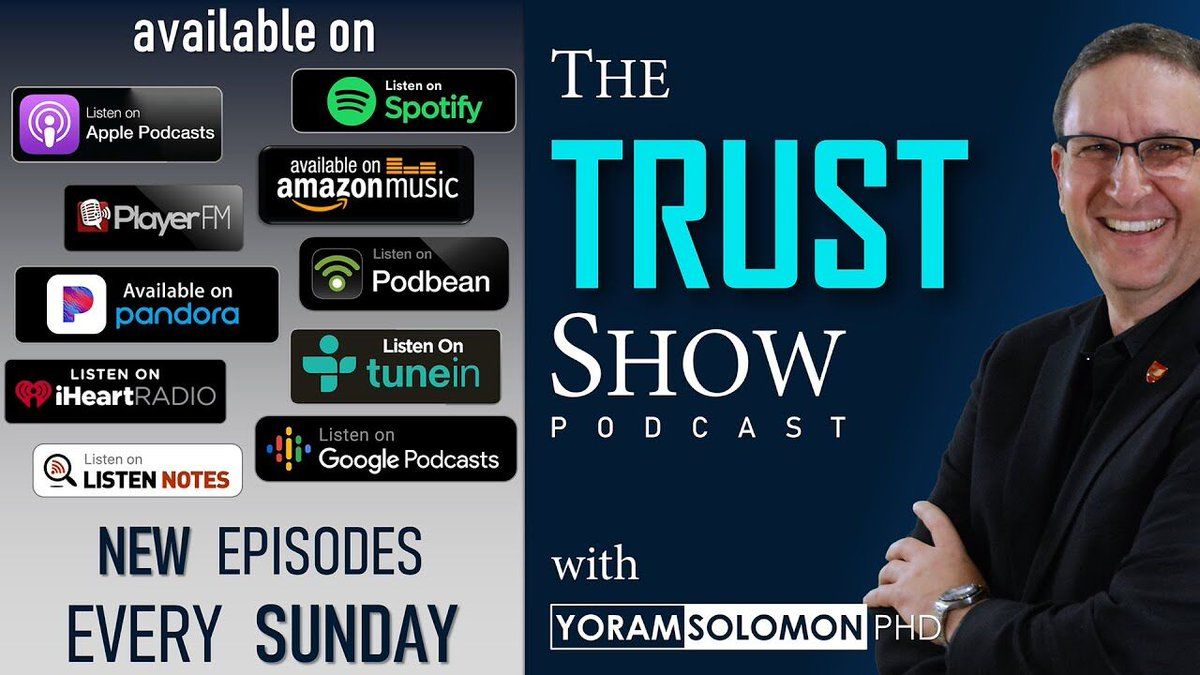What do you feel makes a person trustworthy? Do they keep your secrets? Respect your beliefs and boundaries? When you know someone isn’t trustworthy, it influences how you relate to them. And often, a lack of trust can cause a complete breakdown in a relationship. People need to have others they can trust. Whether it’s in personal relationships, work, or society as a whole, trust is essential.
Dr Yoram Solomon is one of the world’s leading experts on trust. His research in the area has examined what trust actually is, why it matters, and how we can build more of it in our relationships. To date, Yoram has published a total of 14 books and more than 300 articles on trust, innovation culture, and entrepreneurship. His recent publication, The Book of Trust aims to show readers how they can build the most important quality they have: trustworthiness.
Yoram is also a TEDx speaker, an adjunct professor at Southern Methodist University, and has appeared as a guest on countless podcasts to discuss the implications of his research. He also hosts his own solo podcast called The TRUST Show. His trust model was shaped by years of original research and experience as a CEO, elected official, innovator, teacher, pilot, and member of Israel’s IDF 35th Airborne Brigade.

This month we’re showcasing some of the leading Self-Improvement experts within the MatchMaker.fm community. So we caught up with Yoram to learn more about the importance of trust and the things we can do to build it in our relationships at home, work, and in society as a whole.
How do you define trust?
Trust is what allows you to take risks in order to gain positive outcomes. However, when you trust, you are willing to accept the potential negative consequences of giving control over something you have to another person (or thing), expecting them to minimize those consequences. To make it more concrete, let’s look at a specific example.
Say you had just met me for the first time, and I asked you to lend me $20, which I promised to pay back later. The potential benefit to you is that you did something good for me. Maybe you expect reciprocity at a later time. Or maybe if others have seen you hand over the cash, you’ve “built your brand” through that act of goodwill.
So what’s the risk? That you lose $20. It’s pretty limited in this example. But at this point I should clarify that it’s really fear that you balance with trust, rather than risk. The difference? Different people will often have very different levels of fear from the same objective risk.
If you make $50,000 a year, losing $20 would mean more to you than someone who makes a million. You compensate for this risk by trusting that I will return the $20 to you. Trust is your willingness to hand over the $20, and your expectation that I will minimize the negative consequence (losing the money). If you feel you trust me more than you fear the risk of losing $20, you feel safe. If not - you feel danger. It’s as simple as that.
Why is trust so important at work?
The numbers speak for themselves. In my research, I found the three key requirements for a culture of innovation (and a 64% improvement in the company’s levels of productivity) are autonomy, accountability, and the ability to hold constructive disagreement. To function properly, all three of these elements require a high degree of trust to be present within the team.
A 2017 study of 102 projects across multiple industries showed that increasing the level of trust would improve project performance (being on schedule, on budget, and delivering what was expected etc) by 45%. Another research paper puts this number at 61%.
In his book, Trust Factor, Paul Zak provided a few additional correlations between trust and organizational consequences. In high-trust organizations, employees feel 74% less stress, 106% more energy, take 13% fewer sick days, exhibit 76% higher engagement, feel 29% higher job satisfaction and 40% less burnout. Finally, A 2002 study by Watson Wyatt showed that high-trust organizations had a total return to shareholders (stock price plus dividends) that was 286% higher than low-trust organizations.
What are the most common misconceptions people have about trust?
First and foremost, that trust is a universal term. It’s not. It’s relative. Over the years, I’ve observed 8 laws of how trust “behaves.” First, trust is continuous, not binary. Therefore a yes or no question such as “Do you trust me?” is essentially meaningless. “How much do you trust me?” is much more appropriate. Trust is also contextual. There is no universal answer to the question “Do you trust me?” You should add “to do what?”
Trust is also personal and individual. You may trust me more (or less) than someone else trusts me, to do the same thing. As an example, I am an adjunct professor at SMU (Southern Methodist University). One day, I looked up the anonymous reviews by my students on the site ratemyprofessors.com. What stood up to me were two reviews in particular. One gave me 5/5, and the other gave me 1/5. Both justified their rating. The amazing thing was that both students attended the same class in the same semester. They could have even been sitting next to each other. So how come the big disparity? It’s because they see different things in me. They relate to me differently. Trust is the same way.
A second major misconception is that trust is static. It’s not. It’s dynamic. First of all, if you haven’t seen someone in a long while, as a self-defense mechanism you trust them less the next time you see them. You don’t know if they have changed, and therefore should not be trusted to the same extent as you did in the past.
Trust is not static. It’s not only who you are, but also what you do. The “who you are” part, in my model of trustworthiness, includes your competence (technical-professional component), the personality compatibility components (emotional-relational component), and the circumstances of the situation. The “what you do” part includes the time you spend interacting with the other person, the intimacy of those interactions, and the positivity of each interaction. The relative and dynamic characteristics of trust are unique to my framework of trust.
Could you give some simple tips people can use to build trust when interacting with others at work?
Oh, definitely! I wrote a series of books just for this exact purpose. At the time I’m writing this article, I’m also writing the fifth book in the series, Can I TRUST you?. Every book in the series focuses on a specific role. So far I’ve compiled lists of tips for enhancing trust specifically so leaders, project managers, team members, and salespeople. Each page outlines a different tip, and my hope is that these books will help people become more trusted in the role to do day-to-day. But, over time, I also realized that some habits work in almost all situations, and those who master these habits tend to be more trusted. Here are two key elements:
Own your side of (mis)communication. Communication is the act of getting a thought from my brain to yours. However, sometimes this process breaks down. Environmental noise may cause you to hear something different than what came out of my mouth, and then you may misinterpret what you hear. In that situation, whose fault is it? Most people would blame the other person. The problem is when you do that, the other person becomes defensive, and defensive people will not trust you.
Instead, own your side of miscommunication. If you didn’t understand what I said, it must be because I didn’t explain it well. Conversely, if I didn’t understand what you said, it must still be my fault for failing to grasp the point you were making for whatever reason. When you own your side of miscommunication, the other person will trust you more.
Next, get your butt out of your office. When I ran a business unit at Texas Instruments, I used to communicate with my team mostly over email, even though they were located at the same wing of the building as I was. One day, one of my peers told me, “Get your butt out of your office!” Communicating with a high level of intimacy demands that you meet in-person, allowing the other person to see the consistency of your words and non-verbal communication (body language, facial expression). When those are consistent, others will trust you. When they are inconsistent, they will not. And when no non-verbal communications exist (such as in the case of email and text messages), the other person will have to make assumptions that will be either correct or incorrect.
In recent years public trust in government and established institutions has been declining. What do you think has caused this shift? And can it be reversed?
The main reason, in my opinion, is the political polarization that happened in our country over the past several decades. Instead of finding compromises and seeking for win-win solutions, we entrench in polarized positions and seek zero-sum game solutions with a win-lose mentality. When our government behaves this way, so do we, unfortunately.
I have no doubt that this trend can be reversed. But for that to happen, a major change in attitude must take place. People, and organizations, as well as the government, must start focusing on how to be more worthy of their customers and constituents’ trust, rather than how to benefit from them.
What does the future hold for The TRUST Show?
The TRUST Show is, and will likely remain, a solo podcast. My goal is to educate. To help listeners understand trust while giving concrete and actionable advice on how to build trust, be trusted, and know who to trust.
For the most part, Season 1 (10 episodes) covered the foundation of trust, the importance of trust, and the 8 laws of trust that I’ve observed over the years. The second season will start with a deep explanation of the 6 components of trustworthiness, how to assess them, and how to develop them.
Future episodes and seasons will apply the trustworthiness model to different situations, roles, and contexts. They will explain the differences between personality assessments and trustworthiness assessments, and will provide a 7-step process to become more trusted in specific relationships.
If you’d like to book Yoram as a podcast guest, you can connect with him on MatchMaker.fm






